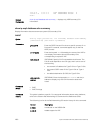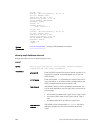
NOTE: ASBRs that are not in directly connected areas are also displayed.
You can determine if an ASBR is in a directly connected area (or not) by the flags.
For ASBRs in a directly connected area, E flags are set. In the following example,
router 1.1.1.1 is in a directly connected area since the Flag is E/-/-/. For remote
ASBRs, the E flag is clear (-/-/-/).
Example
Dell#show ip ospf 1asbr
RouterID Flags Cost Nexthop Interface Area
3.3.3.3 -/-/-/ 2 10.0.0.2 Te 1/1 1
1.1.1.1 E/-/-/ 0 0.0.0.0 - 0
Dell#
show ip ospf database
Display all LSA information. If you do not enable OSPF on the switch, no output is generated.
S4820T
Syntax
show ip ospf process-id [vrf vrf-name] database [database-
summary]
Parameters
process-id Enter the OSPF Process ID to show a specific process. If no
Process ID is entered, command applies only to the first
OSPF process.
vrf vrf-name Enter the keyword vrf and then the name of the VRF to view
LSA information on OSPF processes corresponding to that
VRF.
database-
summary
(OPTIONAL) Enter the keywords database-summary to the
display the number of LSA types in each area and the total
number of LSAs.
Command
Modes
• EXEC
• EXEC Privilege
Command
History
This guide is platform-specific. For command information about other platforms,
refer to the relevant Dell Networking OS Command Line Reference Guide.
The following is a list of the Dell Networking OS version history for this command.
Version Description
9.7(0.0) Introduced on the S6000-ON.
9.4.(0.0) Added support for VRF.
9.0.2.0 Introduced on the S6000.
1308
Open Shortest Path First (OSPFv2 and OSPFv3)


















